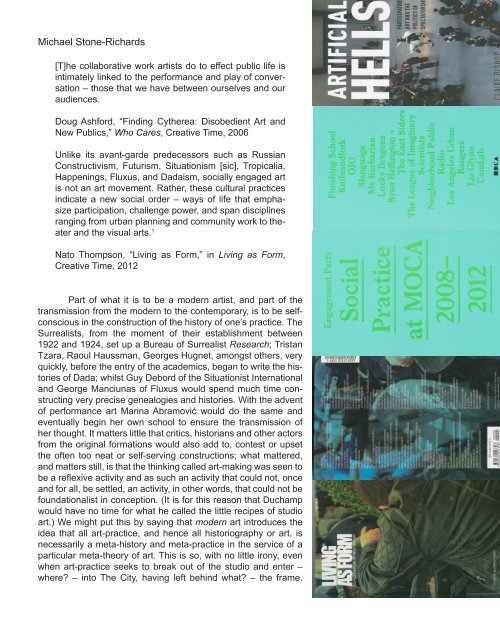Detroit Research Volume 1
You also want an ePaper? Increase the reach of your titles
YUMPU automatically turns print PDFs into web optimized ePapers that Google loves.
120<br />
Michael Stone-Richards<br />
[T]he collaborative work artists do to effect public life is<br />
intimately linked to the performance and play of conversation<br />
– those that we have between ourselves and our<br />
audiences.<br />
Doug Ashford, “Finding Cytherea: Disobedient Art and<br />
New Publics,” Who Cares, Creative Time, 2006<br />
Unlike its avant-garde predecessors such as Russian<br />
Constructivism, Futurism, Situationism [sic], Tropicalia,<br />
Happenings, Fluxus, and Dadaism, socially engaged art<br />
is not an art movement. Rather, these cultural practices<br />
indicate a new social order – ways of life that emphasize<br />
participation, challenge power, and span disciplines<br />
ranging from urban planning and community work to theater<br />
and the visual arts. 1<br />
Nato Thompson, “Living as Form,” in Living as Form,<br />
Creative Time, 2012<br />
Part of what it is to be a modern artist, and part of the<br />
transmission from the modern to the contemporary, is to be selfconscious<br />
in the construction of the history of one’s practice. The<br />
Surrealists, from the moment of their establishment between<br />
1922 and 1924, set up a Bureau of Surrealist <strong>Research</strong>; Tristan<br />
Tzara, Raoul Haussman, Georges Hugnet, amongst others, very<br />
quickly, before the entry of the academics, began to write the histories<br />
of Dada; whilst Guy Debord of the Situationist International<br />
and George Manciunas of Fluxus would spend much time constructing<br />
very precise genealogies and histories. With the advent<br />
of performance art Marina Abramović would do the same and<br />
eventually begin her own school to ensure the transmission of<br />
her thought. It matters little that critics, historians and other actors<br />
from the original formations would also add to, contest or upset<br />
the often too neat or self-serving constructions; what mattered,<br />
and matters still, is that the thinking called art-making was seen to<br />
be a reflexive activity and as such an activity that could not, once<br />
and for all, be settled, an activity, in other words, that could not be<br />
foundationalist in conception. (It is for this reason that Duchamp<br />
would have no time for what he called the little recipes of studio<br />
art.) We might put this by saying that modern art introduces the<br />
idea that all art-practice, and hence all historiography or art, is<br />
necessarily a meta-history and meta-practice in the service of a<br />
particular meta-theory of art. This is so, with no little irony, even<br />
when art-practice seeks to break out of the studio and enter –<br />
where – into The City, having left behind what – the frame.





